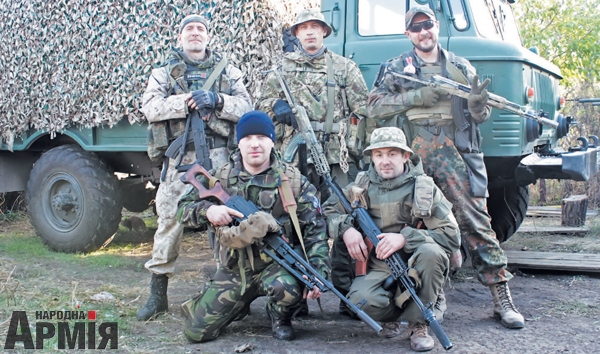
Commander of a reconnaissance troop Senior Warrant Officer Serhii has conducted quite a number of penetrations into adversary frontline positions. During one of them Serhii was injured, while saving his subordinate, but despite this he is back in the field today.
For the instructor of reconnaissance groups at a training area of high-mobility landing troops being sent to the combat area was a question of honor. News from the front about fierce confrontations, reports of the deaths of his former students tormented his soul. He knew that his skills and knowledge were needed at the front. One request, then a second and a third ... finally the request was approved!
Getting accepted by his new team took longer than Sergey had anticipated. Not all of the reconnaissance men wanted to abide by the rules introduced by the new platoon leader. Some of them had to be convinced not only by deeds and words but also via disciplinary measures, while some even had to leave. The daily trainings shaped the team. They started with the basics – orientation on the ground and the complexity increased afterwards: drills of actions when being ambushed, exiting a crossfire site, and so on.
The group received its first combat experience in the area of the anti-terrorist operation under Dokuchaievsk. While returning from a mission, the patrol team came across adversary sappers who were planting mines on a well-trodden path. One was taken down and the other was captured. The “local” militant turned out to be a Yakut.
With each penetration of the forefront, conducted for the sake of gathering information about the formation of the enemy in the interests of a battalion, brigade, neighbors to the left as well as to the right, the group acquired combat experience. However, there were cases when the group had to abort missions. Combat clashes with the enemy in the “gray” zone required a change in the ingress/egress route.
... In an attempt to avoid “surprises” the reconnaissance men were moving slowly. The patrol team was up ahead, the bulk of the group followed behind. A barely noticeable narrow path winding between trees and shrubs of the forest belt forced the fighters to take each step with caution. The abrupt sound from a mortar made the scouts stop at the foot of the terricone. “Have we actually found them?’ - the commander thought hopefully while he pinned their position on the tablet. For a week now the Battalion’s advanced positions had been shelled from an adversary mortar. Detecting the enemy’s position proved to be extremely difficult as the adversary constantly changed their fire nest. The volume of the shots increased. The reconnaissance men lay low at the edge of the thicket in the middle of the terricone. “They’ve already taken off, they were on a white “gazel”, I located their position”, - serviceman with the code name “Rozhok” reported to the commander. “We’ll wait” –came the order from the group senior.
The reconnaissance men waited for the reappearance of the white “gazel” for over a day. They “destroyed” the mortar equipment by themselves. However, on their way back the reconnaissance men were discovered. While making their way out from under enemy fire the sapper did not notice a trip wire. The commander, who was right behind him, reacted to the characteristic sound – he pushed his subordinate to the side but there was no time left for him to leave the engagement zone. Fragments pierced his leg and arm...
The platoon leader did not stay in hospital for very long. Fortunately, the injuries were not very severe, so in a few weeks Serhii was back with his group conducting another combat mission. And one of them was also connected with the search for hostile mortar detachments.
At the Battalion’s headquarters, the group was given only the rough location from where the adversary conducted shellings. “Find them”, – was the request rather than an ordered of the battalion commander.
Serhii’s reconnaissance group examined the terrain right under the enemy’s nose square after square and succeeded ... As it turned out, the enemy placed three mortar sets in mine trolleys. The deadly train came out of the mine on a track and after a strike the militants hurriedly hid it back inside. The enemy was able to change the fire position each time, because the length of the track, which connected the mine with the place where the coal had been shipped off, is considerable. The problem with the mortar train was “solved” with the help of the Brigade’s artillery which struck the target using the given coordinates.
- He is a true commander, a real intelligence officer; he knows and loves his work, - the platoon leader’s subordinates say. – He shares his knowledge and experience with us, teaches us all the tricks of this complex profession. Serhii teaches us to think, to calculate ahead. We train whenever there is a moment to spare. Together, we simulate different situations that may occur during our “walks” into the “gray” zone, we work out our options. We learn to improvise, and once we are reinforced by aerial reconnaissance our improvisations prove to be surprisingly successful.
Serhii says that he is doing what any military man should do when his country finds itself in a state of war:
- We are defending our region from the enemy and we will continue to do so until our last breath…
Serhii FURDY